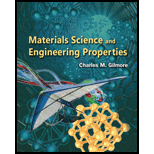
Concept explainers
(a)
The reactions that occur at the two electrode.
(a)
Explanation of Solution
Introduction:
The voltage developed in an electrochemical cell is directly related to the Gibbs free energy change of the reaction. The standard-electrode potentials are determined under equilibrium conditions at room temperature
The copper reduction reaction is more electropositive than the iron reduction reaction.
Copper deposits on the copper electrode in accordance with the reduction reaction.
The copper reduction reaction or the reaction at cathode is given by,
The oxidation reaction at the anode is given by,
Conclusion:
Thus, the reaction at the cathode is
(b)
The voltage developed in the cell.
(b)
Answer to Problem 10.6P
The voltage developed in the cell is
Explanation of Solution
Given:
The mass of copper in the solution is
The volume of solution is
The mass of iron is
Formula Used:
Write the expression for the concentration of copper.
Here,
Write the expression for the concentration of iron.
Here,
Write the expression for the half-cell voltage at the copper electrode.
Here,
Write the expression for the half-cell voltage at the iron electrode.
Here,
Write the expression for the voltage developed in the cell.
Here,
Calculation:
Substitute
Substitute
Substitute
Substitute
Here, negative sign indicate the voltage at anode.
Substitute
Conclusion:
Therefore, the voltage developed in the cell is
Want to see more full solutions like this?
Chapter 10 Solutions
Materials Science And Engineering Properties
- Calculate the BMs (bending moments) at all the joints of the beam shown in Fig.1 using the moment distribution method. The beam is subjected to an UDL of w=65m. L=4.5m L1= 1.8m. Assume the support at C is pinned, and A and B are roller supports. E = 200 GPa, I = 250x106 mm4.arrow_forward||| = 1% 11. LTE2 Voi) Vol) 1. LTE1 SEARCH 8 VYT bartleby.com/dashboard ASK √x MATH SOLV affected resale value at year 5, would that affect perceived value-in-use? How exactly? There is an error in submission of question Check it out! See if this is the solution you're looking for VIEW FULL SOLUTION Not what you're looking for? Keep submitting your original question SUBMIT QUESTIONarrow_forward. The average soil weights for a clay are the following: 2,050 pounds in Loose CY, 2,675pounds in Bank CY, and 2,835 pounds in Compacted CY What is the swell percentage for theclay?arrow_forward
- A traffic count taken between 7:00 a.m. and 2:00 p.m. on a rural highway found the following hourly volumes. Time 7:00-8:00 a.m. Hourly volume 332 8:00-9:00 a.m. 311 9:00-10:00 a.m. 263 10:00-11:00 a.m. 273 11:00 a.m.-12:00 p.m. 289 12:00-1:00 p.m. 1:00-2:00 p.m. 286 265 If these data were collected on a Tuesday in February, estimate the AADT (in veh/day) on this section of highway. Assume that the expansion factors given in this table, this table, and this table apply. veh/dayarrow_forwardA project schedule has been updated. The activity placement of spread footing concretewas originally scheduled to begin as early as day 10. The activity duration is 4 days. The actualstart day was day 12. The original schedule had a calculated total float of 7 days for this activity.The recalculated total float for the activity, when updated, would bearrow_forwardIn preparation for a public hearing, an engineer needs to estimate the travel time savings for a proposed highway bypass of a small city in a rural area. The existing highway goes through the downtown area for 4.1 miles between the points where the bypass will connect. (a) If the engineer anticipates a standard deviation of 7 mi/h and would like a 95% confidence of estimating the mean speed within ±4 mi/h, how many runs should a travel time study include? (Enter the minimum number of runs that achieves a 95% confidence level.) runs (b) If the engineer measures an average speed of 34.9 mi/h through the town and the bypass is expected to operate at speeds of 65 mi/h over a distance of 6.2 miles, what is the expected travel time saving (in minutes) per vehicle? minutes Need Help? Read It Watch Itarrow_forward
 Materials Science And Engineering PropertiesCivil EngineeringISBN:9781111988609Author:Charles GilmorePublisher:Cengage Learning
Materials Science And Engineering PropertiesCivil EngineeringISBN:9781111988609Author:Charles GilmorePublisher:Cengage Learning

